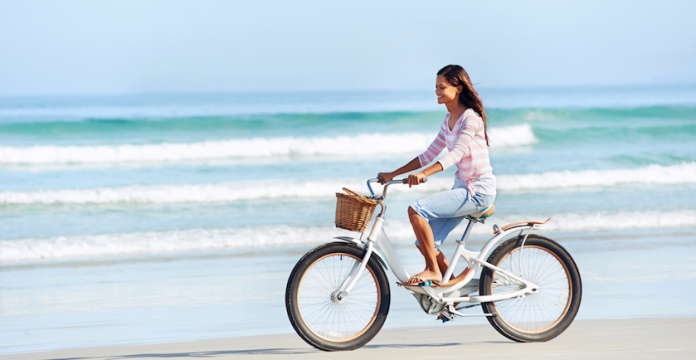
Although irresponsible sunbathing is unquestionably harmful and precautions need to be taken, regular, moderate, unprotected sun exposure is essential for good health. It’s free, easy to come by and good for you when handled wisely. It’s also the only reliable way for your body to generate vitamin D, an essential ingredient for optimizing health and preventing disease.
Trouble is, for the last 30 years or so, the medical-dermatological complex has brainwashed us with the mantra that sun exposure is lethal and we should stay away. It’s an oversimplified view that’s had little effect on curbing skin cancer rates – in fact, they’re skyrocketing – and has managed to make millions of people sun-phobic, causing them to miss out on the numerous benefits associated with sun exposure in limited doses. And the best way to optimize vitamin D levels? It’s with safe, smart and limited sunscreen-free exposure to the sun. Used wisely, strategic bouts of sunshine help the skin produce the Vitamin D it needs to build bones, tamp down inflammation, boost the immune system. Better yet, vitamin D and may actually help prevent as many as 16 different types of cancer including pancreatic, lung, breast, ovarian, skin, prostate and colon.
Read more about screening yourself for skin cancer
Now, of course, taking advantage of the benefits of sunshine is by no means a license to burn and tan with abandon, but consider it permission to step into the light every now and then, with considerably less fear about it than you’ve had in the past. Here are a few pointers on how to support your health with sunshine:
Let the Sun Give You Your Vitamin D – And Yes, There’s an App for That
Your age, complexion, where you live, season and what time of day it is, they all affect the amount of sun exposure you need. The farther north you live, the more sun exposure you’ll need to generate vitamin D. For instance, a fair-skinned New Yorker, sitting on a local beach in June at midday for 10-15 minutes without sun block (enough to cause a light pinkness 24 hours after), will produce the equivalent of 15,000-20,000 IU’s of Vitamin D. Put that same person further north in the U.K, or Canada and they’ll need 20-30 minutes for the same effect. By contrast, people with darker complexions may need 20 – 30 times more exposure to generate the same amount of vitamin D. To help determine your needs, have a look at the tables in Dr. Michael Holick’s The Vitamin D Solution
or download the particularly useful-for-summer app called D Minder which tracks the amount of Vitamin D you get from the sun based on your age, location, body type, and time of day, etc. and even includes a timer so you’ll know when you’ve topped off the D tank, without burning.
Slowly Ramp Up Your Sun Exposure
Kicking off the summer by searing your skin with multiple sunburns is not only painful but also potentially can roll out the welcome mat for melanoma down the line, so bottom line: never burn. Instead, as the summer brings you outdoors more often, don’t be afraid to expose your skin to the sun, just be sure to build up your tolerance slowly over the course of a few weeks. Just don’t rush out and sunburn yourself outdoors or in a tanning booth in hopes of quickly getting a “base” tan all in single afternoon.
Learn How to Sunbathe Smartly
Brief, regular exposures have been found to be much more effective and safer than the occasional long one. And sorry, but sitting by a sunny window just won’t do it, because the UVB rays necessary for vitamin D production are absorbed by glass. To get your Ds, you’ll need to step outside. Set aside some time for short doses of sun-block-free exposure, but if you’ve had skin cancer, check with your doc first. From there, start with a 5-minute shot of unblocked sun for week 1, every other day; step up to 10 minutes the next week, and 15 – 20 minutes for week 3. To maximize your body’s natural Vitamin D production, build up to 20 – 30 minutes of mid-morning sun without sun block. After your 30 minute max dose, it’s time to start sun blocking.
Read more tips for healthy summer skin
Sunburns are the Enemy to Fight – Not the Sun
Some sun exposure is good, but get too much and you’re playing with fire. Remember it’s the repeated sunburns that have been linked to melanoma – not regular, moderate sun exposure – so the fewer burns the better, particularly when it comes to kids and those with fair complexions. To keep sunburns at bay this summer make sure you:
- Never fall asleep in the sun without protection
- Don’t get fooled by cloudy days – they can burn you just as easily as a sunny one
- Protect your skin, particularly if you’re in and out of the water, on a boat or cycling, when the breezes can make you less aware that you’re getting sun burned
- Wear a hat, sunglasses and light-colored clothing to block the sun when out for longer periods
- When it’s time to apply sunscreen, use one with as few chemicals as possible
- Before you buy a sunscreen, first check out the Environmental Working Group’s list of safer sunscreens
- Optimize vitamin D levels and its protective effects with a combinations of controlled sun exposure, a healthy whole food diet and supplementation with vita D3
- And no matter what the season, please stay away from tanning beds!
For more ideas on what sun-induced vitamin D does for you, check out my post, Symptoms and Diseases Associated with Vitamin D Deficiency, on what happens when you fall short. My advice? Don’t! And get out there and enjoy the summer!
This article originally appeared on DrFrankLipman.com
Image: DonParmiggiano










